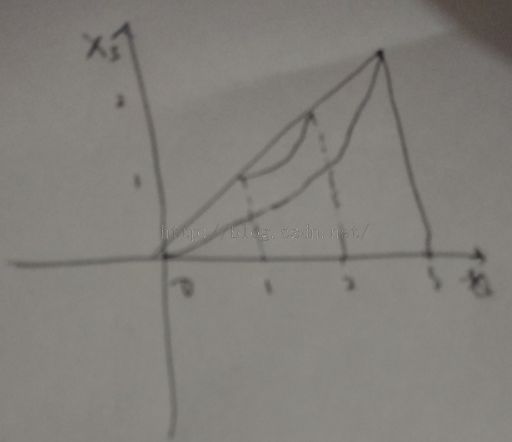ValueAnimator
一句话概括,就是绘制一条二次曲线。
ValueAnimator animator = new ValueAnimator();
PropertyValuesHolder propertyValuesHolder = PropertyValuesHolder.ofFloat("x", 0, 100, 200, 300);
animator.setValues(propertyValuesHolder);
animator.setDuration(2000);
animator.addUpdateListener(new ValueAnimator.AnimatorUpdateListener() {
@Override
public void onAnimationUpdate(ValueAnimator animation) {
float x = (Float) animation.getAnimatedValue("x");
textView.setY(x);
}
});
animator.start();
第一个知识点,Keyframe ,关键帧。
它的子类 FloatKeyframe,主要就三个属性 mFraction ,mValue,mInterpolator。
public static KeyframeSet ofFloat(float... values) {
boolean badValue = false;
int numKeyframes = values.length;
FloatKeyframe keyframes[] = new FloatKeyframe[Math.max(numKeyframes,2)];
if (numKeyframes == 1) {
keyframes[0] = (FloatKeyframe) Keyframe.ofFloat(0f);
keyframes[1] = (FloatKeyframe) Keyframe.ofFloat(1f, values[0]);
if (Float.isNaN(values[0])) {
badValue = true;
}
} else {
keyframes[0] = (FloatKeyframe) Keyframe.ofFloat(0f, values[0]);
for (int i = 1; i < numKeyframes; ++i) {
keyframes[i] =
(FloatKeyframe) Keyframe.ofFloat((float) i / (numKeyframes - 1), values[i]);
if (Float.isNaN(values[i])) {
badValue = true;
}
}
}
if (badValue) {
Log.w("Animator", "Bad value (NaN) in float animator");
}
return new FloatKeyframeSet(keyframes);
}最后的 Keyframe 就是 (0,0,null),(1/3,100,null),(2/3,200,null),(1,300,null)。
第二个知识点,Interpolator。
这还是个函数。。。。
最简单的线性函数
public class LinearInterpolator extends BaseInterpolator implements NativeInterpolatorFactory {
public LinearInterpolator() {
}
public LinearInterpolator(Context context, AttributeSet attrs) {
}
public float getInterpolation(float input) {
return input;
}
/** @hide */
@Override
public long createNativeInterpolator() {
return NativeInterpolatorFactoryHelper.createLinearInterpolator();
}
}其实就是 y = x 啊。
public class AccelerateDecelerateInterpolator extends BaseInterpolator
implements NativeInterpolatorFactory {
public AccelerateDecelerateInterpolator() {
}
@SuppressWarnings({"UnusedDeclaration"})
public AccelerateDecelerateInterpolator(Context context, AttributeSet attrs) {
}
public float getInterpolation(float input) {
return (float)(Math.cos((input + 1) * Math.PI) / 2.0f) + 0.5f;
}
/** @hide */
@Override
public long createNativeInterpolator() {
return NativeInterpolatorFactoryHelper.createAccelerateDecelerateInterpolator();
}
}无论是怎么样差值器,总得经过 (0.0) 和 (1,1),不同的只是趋势。
第三,计算 fraction。
分子的意思。
第一次计算:
float fraction = mDuration > 0 ? (float)(currentTime - mStartTime) / mDuration : 1f;这代表动画时间已经过去的百分比。
第二次计算:
fraction = mInterpolator.getInterpolation(fraction);直线可能变成了曲线,经过 (0,0) 和 (1.1)。
第三次计算:
public float getFloatValue(float fraction) {
FloatKeyframe prevKeyframe = (FloatKeyframe) mKeyframes.get(0);
for (int i = 1; i < mNumKeyframes; ++i) {
FloatKeyframe nextKeyframe = (FloatKeyframe) mKeyframes.get(i);
if (fraction < nextKeyframe.getFraction()) {
final TimeInterpolator interpolator = nextKeyframe.getInterpolator();
float intervalFraction = (fraction - prevKeyframe.getFraction()) /
(nextKeyframe.getFraction() - prevKeyframe.getFraction());
float prevValue = prevKeyframe.getFloatValue();
float nextValue = nextKeyframe.getFloatValue();
// Apply interpolator on the proportional duration.
if (interpolator != null) {
intervalFraction = interpolator.getInterpolation(intervalFraction);
}
return mEvaluator == null ?
prevValue + intervalFraction * (nextValue - prevValue) :
((Number)mEvaluator.evaluate(intervalFraction, prevValue, nextValue)).
floatValue();
}
prevKeyframe = nextKeyframe;
}
// shouldn't get here
return ((Number)mKeyframes.get(mNumKeyframes - 1).getValue()).floatValue();
}两帧情况省略了,超过1或者低于0的也忽略了。
关键帧是可以设置差值器的,这意味每两个关键帧之间,可以再一次改变趋势,和之前的差值器叠加在一起。
直到 fraction 到 1 之前,每过 10ms (16ms)会获取下一帧的 value。
基本就是这样。
推荐:
http://blog.csdn.net/xushuaic/article/details/40424379
